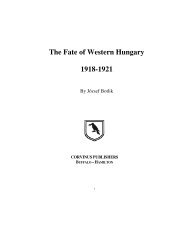the text - Corvinus Library - Hungarian History
the text - Corvinus Library - Hungarian History
the text - Corvinus Library - Hungarian History
Create successful ePaper yourself
Turn your PDF publications into a flip-book with our unique Google optimized e-Paper software.
territories. After <strong>the</strong> Turks were driven out at <strong>the</strong> end of <strong>the</strong> 17th<br />
century, <strong>the</strong> Habsburg policy of resettling <strong>the</strong> depopulated regions<br />
invited not only German immigrants but also Serbians for <strong>the</strong><br />
sou<strong>the</strong>rn borders. They were promised tax-exemptions, religious<br />
freedom and <strong>the</strong> establishment of an Eastern-rite bishopric. The<br />
invitation of Vienna did not fall on deaf ears in <strong>the</strong> Serb population<br />
suffering under Turkish rule: in that decade, 200,000 Serbians<br />
arrived, led by <strong>the</strong> Patriarch Arsenije Crnojevic (Arzen Csernovics),<br />
to settle <strong>the</strong> depopulated sou<strong>the</strong>rn regions. In 1692 and 1695,<br />
Emperor Leopold I.'s privileges granted collective rights and<br />
exemptions to <strong>the</strong> Serbians settling in. These will become <strong>the</strong> basis<br />
of <strong>the</strong> l9th century's erupting nationalist movement. It was Vienna's<br />
deliberate policy to grant <strong>the</strong>se privileges: she wanted to build on<br />
<strong>the</strong>m to play Hungary off. Later, Joseph I, Charles "I, and Maria<br />
Theresia all confirmed <strong>the</strong>se privileges, thus effectively removing<br />
<strong>the</strong>se Serbian-inhabited border regions from Hungary's<br />
administrative supervision. This separatism was significant not only<br />
from <strong>the</strong> legal and ethnic point of view, but also in its religious<br />
aspect as <strong>the</strong> head of <strong>the</strong> Serbian Church in Hungary was as well its<br />
temporal head. With <strong>the</strong> end of <strong>the</strong> 17th century, one of <strong>the</strong> Middle<br />
Ages' largest migration closed. Its aim was our country's territory<br />
and, as a consequence, created this significant sou<strong>the</strong>rn-Slav<br />
minority in Hungary *4.<br />
The Polish refugees arriving from time to time on <strong>the</strong> <strong>Hungarian</strong><br />
nation's soil - except for those from <strong>the</strong> Szepesseg and <strong>the</strong> borders<br />
of Poland and Hungary - are typical of all phases of <strong>the</strong> care given<br />
historically to refugees (emigration, social work, etc.). The political<br />
and economic decline of <strong>the</strong> Polish state in <strong>the</strong> 18th century stirred<br />
<strong>the</strong> ambitions of her neighbors (Austria, Russia, and Prussia) to<br />
acquire additional territory. Between 1772 and 1796, <strong>the</strong>y divided<br />
three times Poland's territory. At <strong>the</strong> beginning of <strong>the</strong> l9th century,<br />
Polish patriots hoped for redress from <strong>the</strong> Napoleonic wars but his<br />
fall sealed <strong>the</strong>ir fate. At <strong>the</strong> Congress of Vienna (1815) <strong>the</strong> Holy<br />
Alliance declared its final decision: <strong>the</strong>y attached to Prussia <strong>the</strong><br />
industrially more advanced western part (<strong>the</strong> Grand Duchy of<br />
Poznan), to Russia <strong>the</strong> central and eastern territories (Kingdom of<br />
Poland), and Austria received Galicia. The Republic of Cracow<br />
represented <strong>the</strong> Polish State under <strong>the</strong> supervision of <strong>the</strong> three<br />
powers.<br />
The three territories developed very differently. The fate of <strong>the</strong><br />
Poles living under German rule depended on <strong>the</strong> strong<br />
Germanization process. Under Bismarck's chancellorship, for<br />
8
















